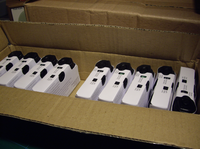In the Designing for Services project, we are making use of both design research methods and social science research methods. An example of the former is the "cultural probes" pack sent out to participants before the first event. The aim of this pack was to stimulate participants' thinking about services by sending them something materially related to service design and provision - and to capture some of these thoughts using the pack itself.
Our pack - a white cardboard "Chinese food pail" - contained the following:
- a disposable camera, with some suggestions of photos to take such as: a favourite product, a favourite service, a service that is very nationally or ethnically specific, a service based on a 19th century technology, a service in which the participant hates being the user
- an imaginary invoice for the participant's services to the research project
- a napkin with an area for writing about the sorts of messes that happen in service design and provision
- an instruction on the bottom to use the pack to write down the intellectual takeaways the participant would like from the project
- an explanatory letter (available as pdf)
During January we will review participants' responses, and then use them in the next workshop at the end of the month.
Find out more>> see the photos of our probes pack and how some participants used it in this project blog's photo gallery.
Read about cultural probes as a design research method in a paper by its creators Bill Gaver, Tony Dunne and Elena Pacenti.
Thanks to Michele Gauler for helping me with the design and production of the packs. 

Hi all,
Just a quick word on the cultural probes packs. For me it was the first time I saw and had to do one. It was fun! It felt like homework again (in a positive sense). I took mine home in the evening and took pictures on the way to and from work. Taking the pictures and doing the other exercises made me feel very creative. I told friends / colleagues who saw me taking pictures that I was working on a science project for school. They were fascinated by the project, started to give me their own examples and asked me today what other pictures were there at the workshop (and whether anyone from Tesco or HSBC came to see who complained about their bad service). Unfortunately, the pictures were not ready in time for yesterday's workshop, but Lucy said we'll use them next time. I think they will be a good starting point to see people's definitions and understandings of service, adding to our continuing discussion about what are services/products/experiences etc. I'm looking forward to unraveling patterns in good/bad service examples and our personal assumptions about service design!
Leonieke
Posted by: Leonieke Zomerdijk | Jan 30, 2007 at 11:57